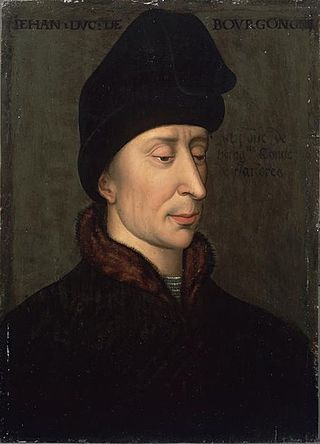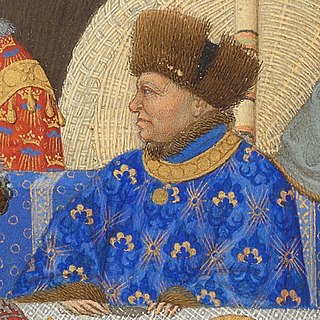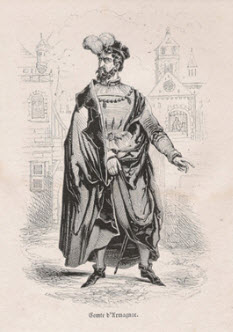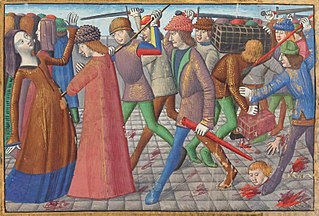Charles, Count of Armagnac may refer to:
- Charles I, Count of Armagnac (r. 1473–1497)
- Charles IV, Duke of Alençon and Count of Armagnac (r. 1509–1525)
- Charles de Lorraine, Count of Armagnac (r. 1718–1751)
Charles, Count of Armagnac may refer to:
The County of Armagnac, situated between the Adour and Garonne rivers in the lower foothills of the Pyrenées, was a historic county of the Duchy of Gascony, established in 601 in Aquitaine. In 960, the title of 'Count of Armagnac' was established, and thus the County of Armagnac was created. In 1751, following the death of childless Charles de Lorraine, Comte d'Armagnac, the county was absorbed into the Crown lands of France and the King, then Louis XV took the title of 'Count of Armagnac'. In 1791, following the decree dividing France into departments, the county was disestablished, but remains an important natural region of France.

John I was a scion of the French royal family who ruled the Burgundian State from 1404 until his assassination in 1419. He played a key role in French national affairs during the early 15th century, particularly in the struggles to rule the country for the mentally ill King Charles VI, his cousin, and the Hundred Years' War with England. A rash, ruthless and unscrupulous politician, John murdered the King's brother, the Duke of Orléans, in an attempt to gain control of the government, which led to the eruption of the Armagnac–Burgundian Civil War in France and in turn culminated in his own assassination in 1419.

John of Berry or John the Magnificent was Duke of Berry and Auvergne and Count of Poitiers and Montpensier. He was Regent of France from 1380 to 1388 during the minority of his nephew Charles VI. His brothers were King Charles V of France, Duke Louis I of Anjou and Duke Philip the Bold of Burgundy.

The following is a list of rulers of the county of Armagnac:

John V of Armagnac was the penultimate Count of Armagnac of the older branch. He was the son of John IV of Armagnac and Isabella of Navarre.
Armagnac may refer to:
The Armagnac faction was prominent in French politics and warfare during the Hundred Years' War. It was allied with the supporters of Charles, Duke of Orléans against John the Fearless after Charles' father Louis of Orléans was killed on a Paris street on the orders of the Duke of Burgundy on 23 November 1407.

Bernard VII, Count of Armagnac was Count of Armagnac and Constable of France. He was the son of John II, Count of Armagnac, and Jeanne de Périgord. He succeeded in Armagnac at the death of his brother, John III, in 1391. After prolonged fighting, he also became Count of Comminges in 1412.

The Cabochien revolt was an episode in the civil war between the Armagnacs and the Burgundians which was in turn a part of the Hundred Years' War.
Charles of Lorraine may refer to:
The County of Fézensac was an 8th-century creation on the north-eastern fringes of the Duchy of Gascony following Charlemagne's policy of feudalisation and Frankish colonisation. The move was aimed at offsetting and undermining the authority of the duke of Gascony Lupo II after the setback suffered by the Franks at the Battle of Roncevaux in 778 and failure to restrain the Basques. That advance clearly displeased the Basques, with these policies sparking a stir on the banks of the Garonne.
Bonne of Berry was a French countess. She was Countess of Savoy by marriage to Amadeus VII, Count of Savoy. When she was widowed, she unsuccessfully claimed the regency during her son's minority against her mother-in-law in 1391–93. As niece of King Charles V of France, she played a key role in French diplomatic maneuvers intended to consolidate the alliances of the kingdom of France.
John IV was a Count of Armagnac, Fézensac, and Rodez from 1418 to 1450. He was involved in the intrigues related to the Hundred Years' War and in conflicts against the King of France.

The Armagnac–Burgundian Civil War was a conflict between two cadet branches of the French royal family – the House of Orléans and the House of Burgundy from 1407 to 1435. It began during a lull in the Hundred Years' War against the English and overlapped with the Western Schism of the papacy.

Anne of Armagnac, Dame d'Albret, Countess of Dreux was a French noblewoman and a member of the powerful Gascon Armagnac family which played a prominent role in French politics during the Hundred Years War and were the principal adversaries of the Burgundians throughout the Armagnac-Burgundian Civil War. Anne was the wife of Charles II d'Albret.

Joan of Armagnac was a French noblewoman of the Armagnac family, being the eldest daughter of Count John I of Armagnac and his wife Beatrice of Clermont. She became Duchess of Berry by her marriage to John, Duke of Berry in 1360.
John II, the Hunchback,, Count of Armagnac, of Fézensac, Rodez (1371–1384) and Count of Charolais (1364–1384), Viscount Lomagne and Auvillars, he was the son of John I, Count of Armagnac, of Fezensac and Rodez, Viscount Lomagne and Auvillars and Beatrix de Clermont, great-granddaughter of Louis IX of France.
The House of Armagnac is a French noble house established in 961 by Bernard I, Count of Armagnac. It achieved its greatest importance in the fourteenth and fifteenth centuries.
Charles I may refer to:

Louis of Lorraine was the Count of Armagnac from his father's death in 1666. The Grand Squire of France, he was a member of a cadet branch of the House of Guise, itself a cadet branch of the sovereign House of Lorraine. His descendants include Albert II, Prince of Monaco, Umberto II of Italy, and Diana Álvares Pereira de Melo, 11th Duchess of Cadaval.